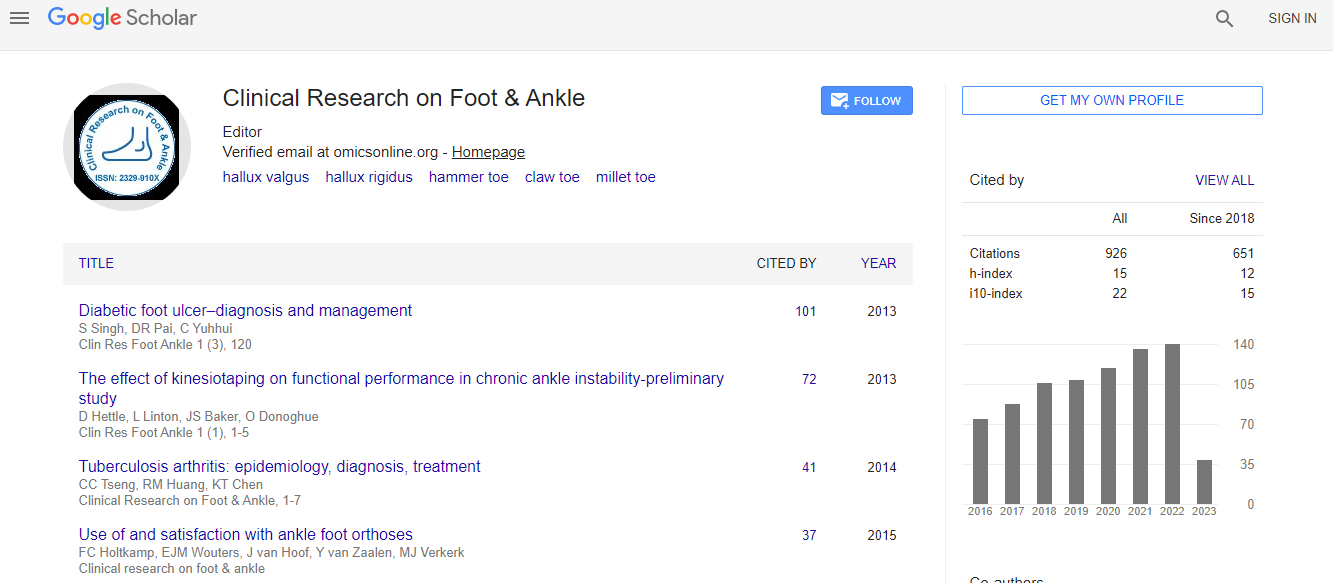Research Article
The Effect of Kinesiotaping on Functional Performance in Chronic Ankle Instability-Preliminary Study
David Hettle1*, Linda Linton2, Julien S Baker3 and Orna Donoghue41University of Edinburgh Medical School, University of Edinburgh, United Kingdom
2FASIC, Centre for Sport and Exercise, University of Edinburgh, United Kingdom
3Institute of Sport, Physical Education and Health Sciences, University of Edinburgh, United Kingdom
4Institute of Clinical Exercise and Health Science, University of the West of Scotland, United Kingdom
- *Corresponding Author:
- Dr. David Hettle
Foundation Year 1 Doctor
Aberdeen Royal Infirmary
Foresterhill Road, Aberdeen
AB25 2ZN, United Kingdom
Tel: 07887 352 245
E-mail: david.hettle@nhs.net
Received Date: January 24, 2013; Accepted Date: April 04, 2013; Published Date: May 06, 2013
Citation: Hettle D, Linton L, Baker JS, Donoghue O (2013) The Effect of Kinesiotaping on Functional Performance in Chronic Ankle Instability-Preliminary Study. Clin Res Foot Ankle 1:105. doi: 10.4172/2329-910X.1000105
Copyright: © 2013 Hettle D, et al. This is an open-access article distributed under the terms of the Creative Commons Attribution License, which permits unrestricted use, distribution, and reproduction in any medium, provided the original author and source are credited.
Abstract
Objective: Chronic Ankle Instability (CAI) is characterised by recurrent giving way and often develops after repeated lateral ankle sprains. Kinesiotape is more elastic than traditional athletic tape and is becoming increasingly popular. It is reported to decrease pain, improve muscle function, circulation and proprioception, however, research examining the effects of Kinesiotape in CAI is limited. The objective of this study was to determine if applying Kinesiotape to chronically unstable ankles improved performance in the Star Excursion Balance Test (SEBT).
Design: Crossover design study with participants randomised to the taped or untaped condition first.
Setting: Lab-based study.
Participants: Sixteen participants (10 female, 6 male; age 22.4 ± 1.41 years; height 1.77 ±0 .08 m; weight 71.9 ± 8.7 kg) from university sports clubs participated in the study. Inclusion criteria was a lateral ankle sprain in the previous year, self-reported history of CAI and Cumberland Ankle Instability Tool score <24.
Intervention: Kinesiotape was applied to the affected ankles using an adapted form of the lateral sprain technique and participants waited 20 min after application or removal before testing.
Main Outcome Measures: Reach distances were measured in antero-medial, medial and postero medial directions of the SEBT in taped and untaped conditions.
Results: There were no significant differences in reach distance in any direction of the SEBT between taped and untaped conditions (p>0.05).
Conclusion: Kinesiotape did not improve reach distance in the SEBT in young, active individuals with CAI. Further research examining the therapeutic effectiveness of Kinesiotape in CAI is warranted.

 Spanish
Spanish  Chinese
Chinese  Russian
Russian  German
German  French
French  Japanese
Japanese  Portuguese
Portuguese  Hindi
Hindi 
